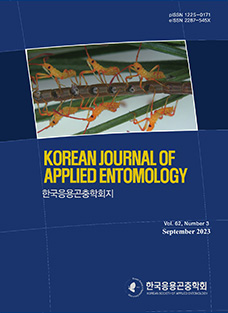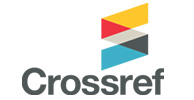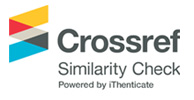The genus Homalotylus was erected by Mayr (1876) based on the type species Encyrtus flaminius Dalman. This genus belongs to the subfamily Encyrtinae and either in the tribe Homalotylini, subtribe Homalotylina (Trjapitzin, 1989) or the tribe Echthroplexiellini, subtribe Homalotylina (Noyes, 2010).
Homalotylus species are generally primary parasitoids of larvae of ladybird beetles (Coleoptera: Coccinellidae), emerging from the prepupal stage of Coccinelllids and feeding on hemipterous pests (aphids, scales and allies) (Zu et al., 2023). The hosts records of mealy bugs and aphids are probably erroneous (Noyes, 2010). Sixty-six species of Homalotylus have been described worldwide (Noyes, 2019). Until now, only one species, H. flaminius (Dalman, 1820), of the genus has been known from Korea.
The aim of the study is to report a newly recorded species, Homalotylus albofrons to Korean fauna. We provide diagnostic characters and figures of the species.
Material and Methods
All the examined specimens are deposited in the Laboratory of Systematic Entomology, Chungnam National University (CNU), Daejeon, South Korea. Morphological terminology follows Gibson et al. (1997). Photographs were taken with a Leica M165C and Leica DMC2900 microscope (Wetzlar, Germany) and Helicon Focus 7 Software (Helicon Soft Ltd.) was used in image stacking.
Systematic Accounts
Family Encyrtidae Walker, 1837
Genus HomalotylusMayr, 1876
NobrimusThomson, 1876: 137–138.
MendozaniellaBrèthes, 1913: 97–98.
HemaenasioideaGirault, 1916: 307.
AnisotylusTimberlake, 1919: 170–171.
LepidaphycusBlanchard, 1936: 13–14.
NeoaenasioideaAgarwal, 1966: 71.
HomalotylusMayr, 1876: 752–753.
A key to the Korean Homalotylus species
-
1. Antennal funicle 5-segment dark brown, 6-segment completely white; frontovetex dark brown with metallic sheen; fore wing 2.94× as long as width ···· H. flaminius
-
- Antennal funicle three-six-segments white, first segment completely dark brown and second segment pale white; frontovetex white; fore wing 2.49× as long as width ······· ······································································ H. albfrons
Homalotylus albifrons (Ishii, 1925) (Korean name: Eol-gulno- ran-mu-dang-ggang-chung-jom-beol) (Fig. 1A-F)
Anisotylus albifronsIshii, 1925: 28–30.
Homalotylus albifrons (Ishii, 1925): 28–30.
Female
Coloration: Body color dark brown with metallic green sheen; frontovertex yellowish white; antennae dark brown without three-six flagellar segments, clava white; basal half of tegula white, apical half dark brown; wing hyaline; mid leg pale brown except for apical tibia yellowish white, mid tarsus white, hind tarsus pale brown.
Diagnosis. Body (Fig. 1A) length 1.7–1.8 mm; Head (Fig. 1B) in front view 1.15× higher than wide, rather oval in shape; Frontovertex 0.2× head width ocelli in acute-angled triangle, posterior ocelli very close to eye margin(Fig. 1C), and separated from occipital margin by twice their diameter; torulus oval in shape, separated from each other by one-fifth width of the head; mandibles bidentate. Antennae (Fig. 1D) 1.14 mm in length; scape cylindrical; pedicel little shorter than the first two funicle joints combined. Sculpture on mesoscutum (Fig. 1E) and scutellum similar to that on head; mesoscutum 0.6× as long as wide; scutellum 0.89× as long as wide. Fore wing (Fig. 1F) 1.63 mm in length and 0.65 mm in width; submarginal, marginal, stigmal and postmarginal veins with ratio of 65: 3: 14: 8.
Material examined. KOREA: 2♀, Sucheong-ro, Osan-si, Gyeonggi-do, 37°10'12.73"N, 127°3'16.58"E, 20.VII.2022., S Choi leg., sweeping.
Distribution. Korea (new record), Japan.
Host.Sasajiscymnus hareja (Weise, 1879) (Trjapitzin, 1989)










 KSAE
KSAE





